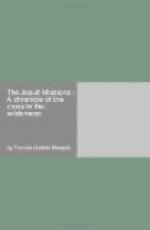On the 6th or 7th of July, in company with a party of Hurons, Le Caron set out from the island of Montreal. The Hurons had come down to trade, and to arrange with Champlain for another punitive expedition against the Iroquois, and were now returning to their own villages. It was a laborious and painful journey—up the Ottawa, across Lake Nipissing, and down the French River—but at length the friar stood on the shores of Lake Huron, the first of white men to see its waters. From the mouth of the French River the course lay southward for mere than a hundred miles along the east shore of Georgian Bay, until the party arrived at the peninsula which lies between Nottawasaga and Matchedash Bays. Three or four miles inland from the west shore of this peninsula stood the town of Carhagouha, a triple-palisaded stronghold of the Hurons. Here the Indians gave the priest an enthusiastic welcome and invited him to share their common lodges; but as he desired a retreat ’in which he could meditate in silence,’ they built him a commodious cabin apart from the village. A few days later Champlain himself appeared on the scene; and it was on the 12th of August that he and his followers attended in Le Caron’s cabin the first Mass celebrated in what is now the province of Ontario. Then, while Le Caron began his efforts for the conversion of the benighted Hurons, Champlain went off with the warriors on a very different mission—an invasion of the Iroquois country. The commencement of religious endeavour in Huronia is thus marked by an event that was to intensify the hatred of the ferocious Iroquois against both the Hurons and the French.
Le Caron spent the remainder of the year 1615 among the Hurons, studying the people, learning the language, and compiling a dictionary. Champlain, his expedition ended, returned to Huronia and remained there until the middle of January, when he and Le Caron set out on a visit to the Petun or Tobacco Nation, then dwelling on the southern shore of Nottawasaga Bay, a two-days’ journey south-west of Carhagouha. There had been as yet no direct communication between the French and the Petuns, and the visitors were not kindly received. The Petun sorcerers or medicine-men dreaded the influence of the grey-robed friar, regarded him as a rival, and caused his teachings to be derided. After an uncomfortable month Champlain and Le Caron returned to Carhagouha, where they remained until the 20th of May, and then set out for Quebec.
When Le Caron reached Quebec on the 11th of July (1616) he found that his comrades had not been idle. A chapel had been built, in what is now the Lower Town, close to the habitation, and here Father Jamay ministered to the spiritual needs of the colonists and laboured among the Indians camped in the vicinity of the trading-post. Father d’Olbeau had been busy among the Montagnais, a wandering Algonquin tribe between Tadoussac and Seven Islands, his reward being chiefly suffering. The filth and smoke of the Indian wigwams tortured him, the disgusting food of the natives filled him with loathing, and their vice and indifference to his teaching weighed on his spirit.




